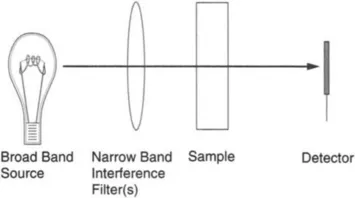
Applied Spectroscopy
A Compact Reference for Practitioners
- 539 pages
- English
- ePUB (mobile friendly)
- Available on iOS & Android
Applied Spectroscopy
A Compact Reference for Practitioners
About this book
This book delineates practical, tested, general methods for ultraviolet, visible, and infrared spectrometry in clear language for novice users, and serves as a reference resource for advanced spectroscopists. Applied Spectroscopy includes important information and equations which will be referred to regularly. The book emphasizes reflectance and color measurements due to their common usage in todays spectroscopic laboratories, and contains methods for selectinga measurement technique as well as solar and color measurements. Written by experts in the field, this text covers spectrometry of new materials, ceramics, and textiles, and provides an appendix of practical reference data for spectrometry.- Book topics include: Practical aspects of spectrometers and spectrometry; Sample preparation; Chemometrics and calibration practices; Reflectance measurements; Standard materials measurements- An emphasis is placed on reflectance and color measurements due to their common usage in today's spectroscopic laboratories- Methods for selecting a measurement technique are included as well as solar measurements and reference information on sources, detectors, optical fiber and window materials
Frequently asked questions
- Essential is ideal for learners and professionals who enjoy exploring a wide range of subjects. Access the Essential Library with 800,000+ trusted titles and best-sellers across business, personal growth, and the humanities. Includes unlimited reading time and Standard Read Aloud voice.
- Complete: Perfect for advanced learners and researchers needing full, unrestricted access. Unlock 1.4M+ books across hundreds of subjects, including academic and specialized titles. The Complete Plan also includes advanced features like Premium Read Aloud and Research Assistant.
Please note we cannot support devices running on iOS 13 and Android 7 or earlier. Learn more about using the app.
Information
OPTICAL SPECTROMETERS
I Introduction



II Types of Spectrometerss
A DISCRETE PHOTOMETERS

B SINGLE BEAM

Table of contents
- Cover image
- Title page
- Table of Contents
- Copyright
- Contributors
- Preface
- Acknowledgments
- 1: The Practical Basics of Spectrometry
- 2: Reflectance Measurements of Solids
- 3: Practical Application of Spectroscopic Measurement
- APPENDIX A: SOURCES, DETECTORS, AND WINDOW MATERIALS FOR UV-VIS, NIR, AND IR SPECTROSCOPY
- APPENDIX B: PRACTICES OF DATA PREPROCESSING FOR OPTICAL SPECTROPHOTOMETRY
- APPENDIX C: INFRARED MICROSPECTROSCOPY
- APPENDIX D
- APPENDIX E: DICHROIC MEASUREMENTS OF POLYMER FILMS USING INFRARED SPECTROMETRY
- Index